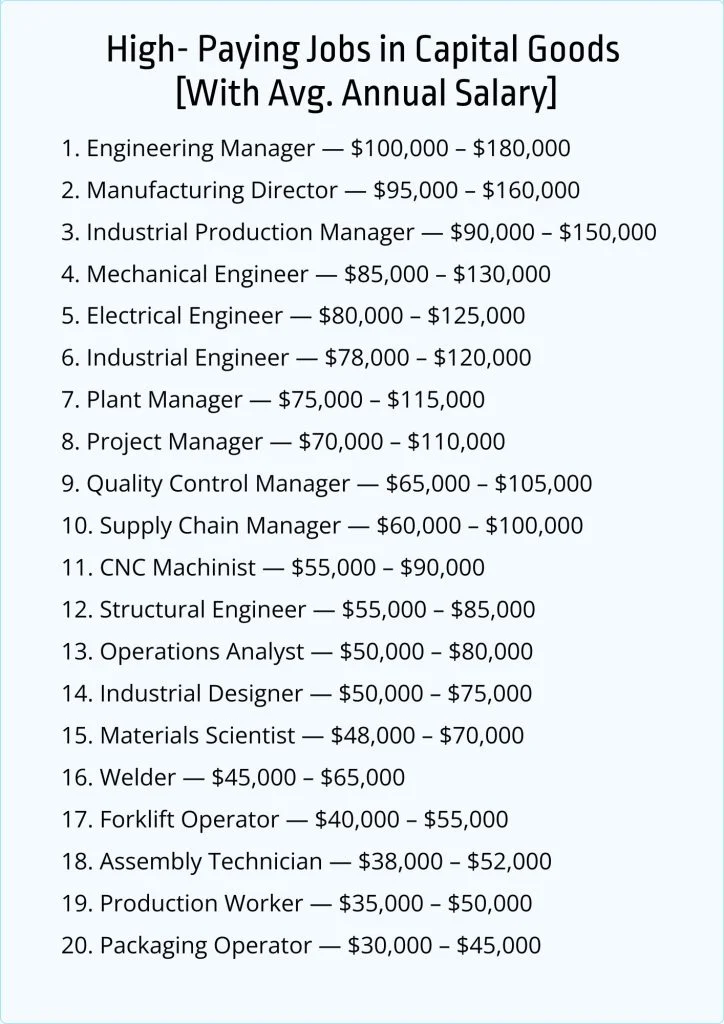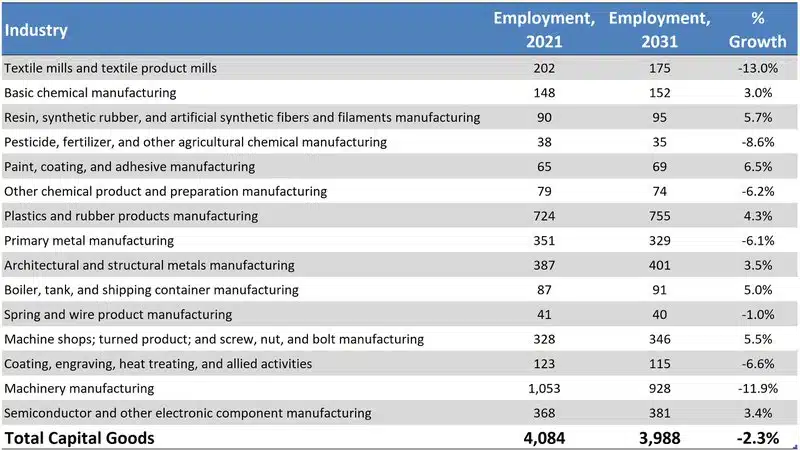If you’re exploring a career in the capital goods industry, you’re considering a sector that drives global economic growth. From machinery manufacturing to infrastructure projects, capital goods are essential for producing other goods and services. But how many jobs are available in capital goods? In this guide, we break down the employment landscape, career paths, salaries, growth projections, and work culture, helping you navigate opportunities effectively.
At WiseWorq, we provide insights on over 25,000 U.S.-based companies, including job availability, company culture, and career growth potential.
What the heck are Capital Goods?
Capital goods are tangible assets used by businesses to produce goods or services. Unlike consumer goods, which are purchased for personal use, capital goods are utilized by companies to manufacture products or provide services. Examples include:
-
Machinery and industrial equipment
-
Tools and manufacturing systems
-
Buildings and infrastructure
-
Electrical and electronic components
Industries that rely on capital goods include machinery manufacturing, construction and engineering, aerospace and defense, and electronics.
Employment Landscape in Capital Goods

The capital goods sector is a major contributor to U.S. employment. According to the National Association of Manufacturers, the industry employs approximately 970,000 to 1.3 million people, ranging from assembly line workers to engineers, project managers, and executives.
Projected Growth
The U.S. Bureau of Labor Statistics projects that employment in machinery and capital goods manufacturing will grow 6% from 2016 to 2026, faster than the national average. This growth is fueled by infrastructure spending, technological advancements, and increased demand for industrial machinery and equipment.
Regional Employment
Job availability varies geographically. Major industrial hubs include:
-
Midwest & Rust Belt: Manufacturing centers in Ohio, Michigan, and Illinois
-
Texas & South: Aerospace, electrical equipment, and oilfield machinery
-
California: Electronics and semiconductor manufacturing
Remote and hybrid roles are slowly expanding into design, engineering, and project management functions.
Key Job Categories in Capital Goods

The capital goods industry offers diverse career paths. Here’s a detailed breakdown:
1. Engineering and Design
Engineers design and improve machinery, systems, and equipment. Common roles include:
-
Mechanical Engineer
-
Electrical Engineer
-
Industrial Designer
Average Salary: $80,000 – $120,000
Skills Required: CAD software, problem-solving, project management
The BLS Occupational Outlook Handbook reports steady demand for engineers in manufacturing and industrial design.
2. Manufacturing and Production
These roles are involved in producing and assembling capital goods:
-
Production Manager
-
Assembly Line Worker
-
Quality Control Inspector
Average Salary: $40,000 – $70,000
Skills Required: Attention to detail, technical knowledge, teamwork
The growth in automation and robotics is reshaping manufacturing roles, creating new positions in technical maintenance and process optimization (BLS Manufacturing Employment Trends).
3. Sales and Marketing
Sales and marketing professionals promote capital goods to businesses:
-
Sales Engineer
-
Product Specialist
-
Marketing Manager
Average Salary: $60,000 – $100,000
Skills Required: Communication, negotiation, market analysis
Industrial sales roles require technical knowledge of products, often combined with business development skills (NAM Industry Insights).
4. Project Management
Project managers oversee operations and production schedules:
-
Project Manager
-
Site Supervisor
-
Logistics Coordinator
Average Salary: $75,000 – $110,000
Skills Required: Leadership, budgeting, scheduling
PMI reports indicate growing demand for skilled project managers in manufacturing and industrial sectors.
Factors Affecting Job Availability
Several key factors determine how many jobs are available in capital goods:
-
Economic Growth: Expansions increase demand for machinery and equipment, boosting employment.
-
Technological Advancements: Automation and robotics reduce some production roles but create technical and maintenance opportunities.
-
Government Policy: Infrastructure investments and defense contracts can significantly impact hiring (BLS Capital Goods Report).
-
Global Trade & Supply Chains: Import/export demand affects manufacturing volumes and employment.
Work Culture in Capital Goods Companies
Work culture varies across companies, but common traits include:
Pros:
-
Structured career paths and advancement opportunities
-
Emphasis on safety and quality
-
Collaboration across engineering, production, and sales teams
Cons:
-
Production roles may involve shift work or physically demanding tasks
-
Some positions have high-pressure deadlines
-
Rapid technological change requires continuous upskilling
Example Companies (Insights from WiseWorq):
-
Alpha Machinery Co: Pros – mentorship programs, rapid growth; Cons – long hours during project deadlines
-
GreenField Equipment: Pros – flexible design engineering roles; Cons – moderate salary growth
-
BlueChip Industrial: Pros – high-tech exposure; Cons – competitive environment
Career Pathways and Advancement
Entry-level roles can evolve into senior positions:
-
Engineer → Senior Engineer → Engineering Manager
-
Production Assistant → Production Supervisor → Plant Manager
-
Sales Representative → Account Manager → Regional Sales Director
Certifications and continuing education enhance employability:
-
Project Management Professional (PMP)
-
Certified Manufacturing Engineer (CMfgE)
-
Lean Six Sigma
Networking through professional organizations such as SME or NAM can also provide career opportunities.
Top Capital Goods Jobs Table
| Job Title | Average Salary | Projected Growth | Key Skills / Certifications | Source |
|---|---|---|---|---|
| Mechanical Engineer | $85,000 | 7% | CAD, Project Management | BLS |
| Electrical Engineer | $88,000 | 8% | Circuit Design, MATLAB | BLS |
| Industrial Designer | $70,000 | 5% | CAD, 3D Modeling | BLS |
| Production Manager | $95,000 | 6% | Leadership, Lean Manufacturing | BLS |
| Assembly Line Worker | $45,000 | 2% | Technical Skills, Attention to Detail | BLS |
| Quality Control Inspector | $55,000 | 4% | Inspection, ISO Standards | BLS |
| Sales Engineer | $95,000 | 7% | Technical Knowledge, Communication | NAM |
| Product Specialist | $80,000 | 5% | Product Knowledge, Market Analysis | NAM |
| Project Manager | $100,000 | 10% | PMP, Scheduling, Budgeting | PMI |
| Logistics Coordinator | $65,000 | 6% | Supply Chain, ERP | BLS |
Conclusion
The capital goods industry offers hundreds of thousands of U.S. jobs across engineering, production, sales, and management. With projected growth and technological innovation driving demand, the sector remains a promising career choice.
Using platforms like WiseWorq, job seekers can research over 25,000 companies, evaluate work culture, and identify roles that match their skills and career goals.


